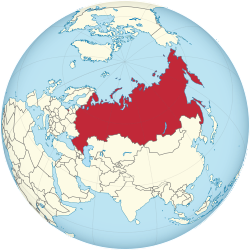|
Borders of Russia
 Russia, the largest country in the world by area, has international land borders with fourteen sovereign states[1] as well as two narrow maritime boundaries with the United States and Japan. There are also two breakaway states bordering Russia, namely Abkhazia and South Ossetia. The country has an internationally recognized land border running 22,407 kilometres (13,923 mi) in total,[1] and has the second-longest land border of any country in the world, after China (22,457 kilometres (13,954 mi)[2]). The borders of the Russian Federation (formerly the Russian SFSR) were mostly drawn since 1956 (save for minor border changes, e.g., with China), and have remained the same after the dissolution of the Soviet Union. In 2014, Russia annexed Ukraine's Crimean peninsula in a move that remains internationally unrecognized. As a transcontinental country in Eurasia, Russia shares borders in both Europe and Asia. Out of the 18 total land borders and maritime boundaries, 12 are in Europe. These countries are Ukraine, Belarus, Poland, Lithuania, Latvia, Estonia, Finland, Norway, Georgia, Azerbaijan, Kazakhstan, Mongolia, China, North Korea and sea borders with Japan, Turkey and the United States. Overview Russia shares land borders with 14 countries owing to its large expanse, tied with China in being more than any other state in the world, but there are sea boundaries with two more countries. Internationally recognizedApproximately from west to east:
Partially recognized
Border detailsBelow is a list of subjects with both neighbouring regions of Russia with them, and in the neighbouring regions of foreign countries. Northwestern Federal District
Volga Federal DistrictSouthern Federal DistrictNorth Caucasian Federal DistrictUral Federal DistrictSiberian Federal District
Far Eastern Federal DistrictCrimeaThe status of the Crimea and of the city of Sevastopol is currently under dispute between Russia and Ukraine; Ukraine and the majority of the international community consider the Crimea to be an autonomous republic of Ukraine and Sevastopol to be one of Ukraine's cities with special status, while Russia, on the other hand, considers the Crimea to be a federal subject of Russia and Sevastopol to be one of Russia's three federal cities since the March 2014 annexation of Crimea by Russia.[3][4] In 2022, Russia declared the annexation of Ukraine's Donetsk, Kherson, Luhansk and Zaporizhzhia regions, which remains internationally unrecognized.[5]
See also
NotesReferences
External links
Wikimedia Commons has media related to International borders of Russia. |
